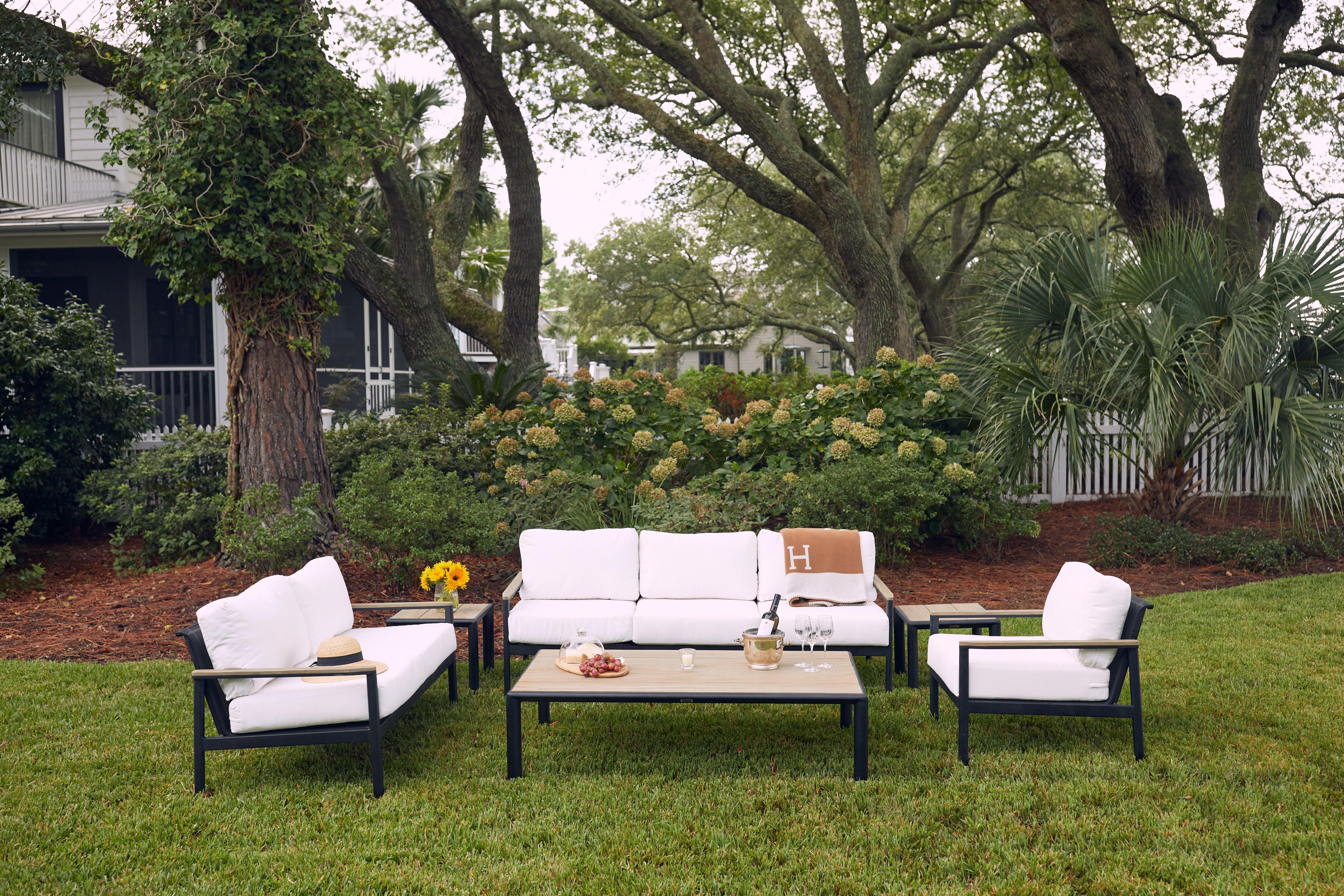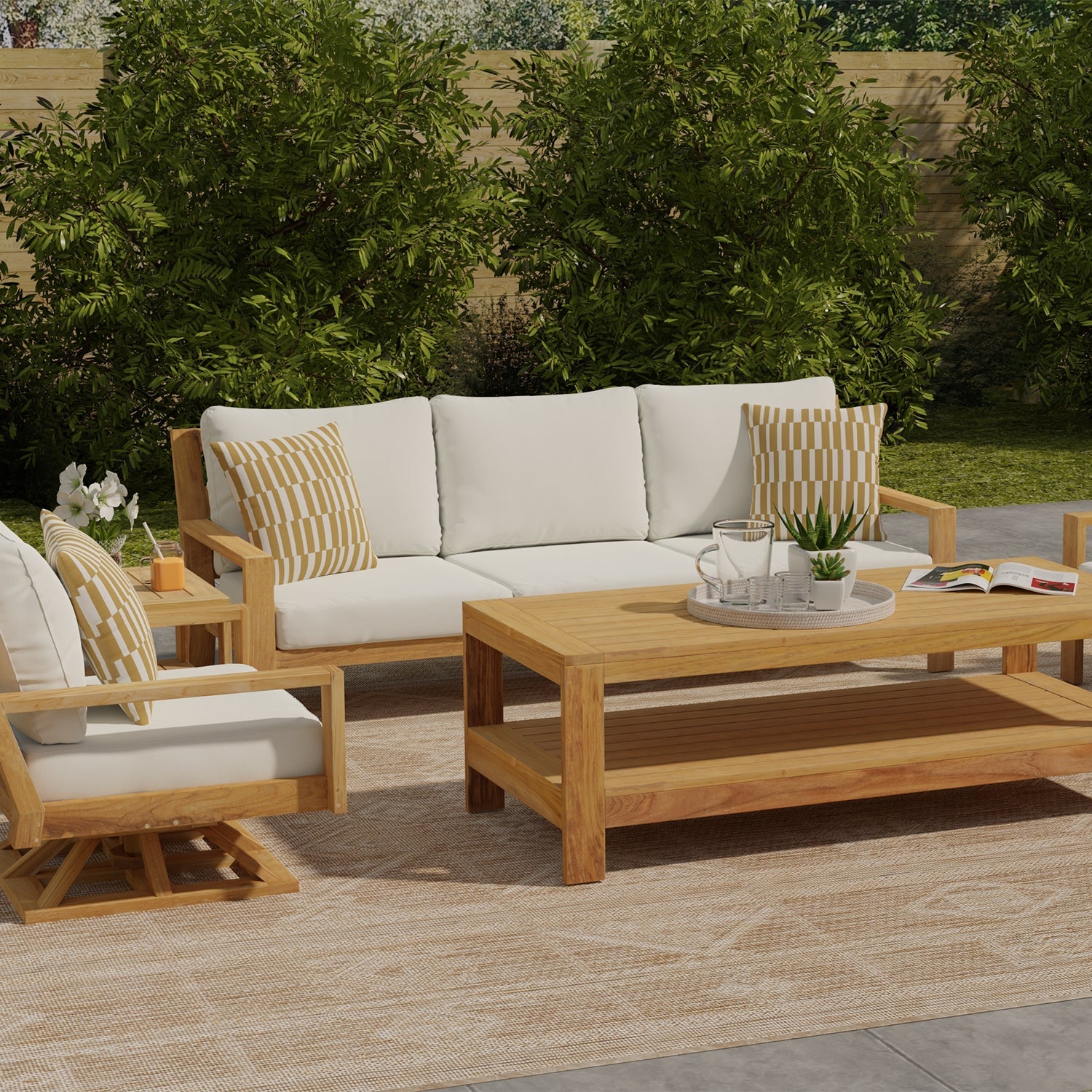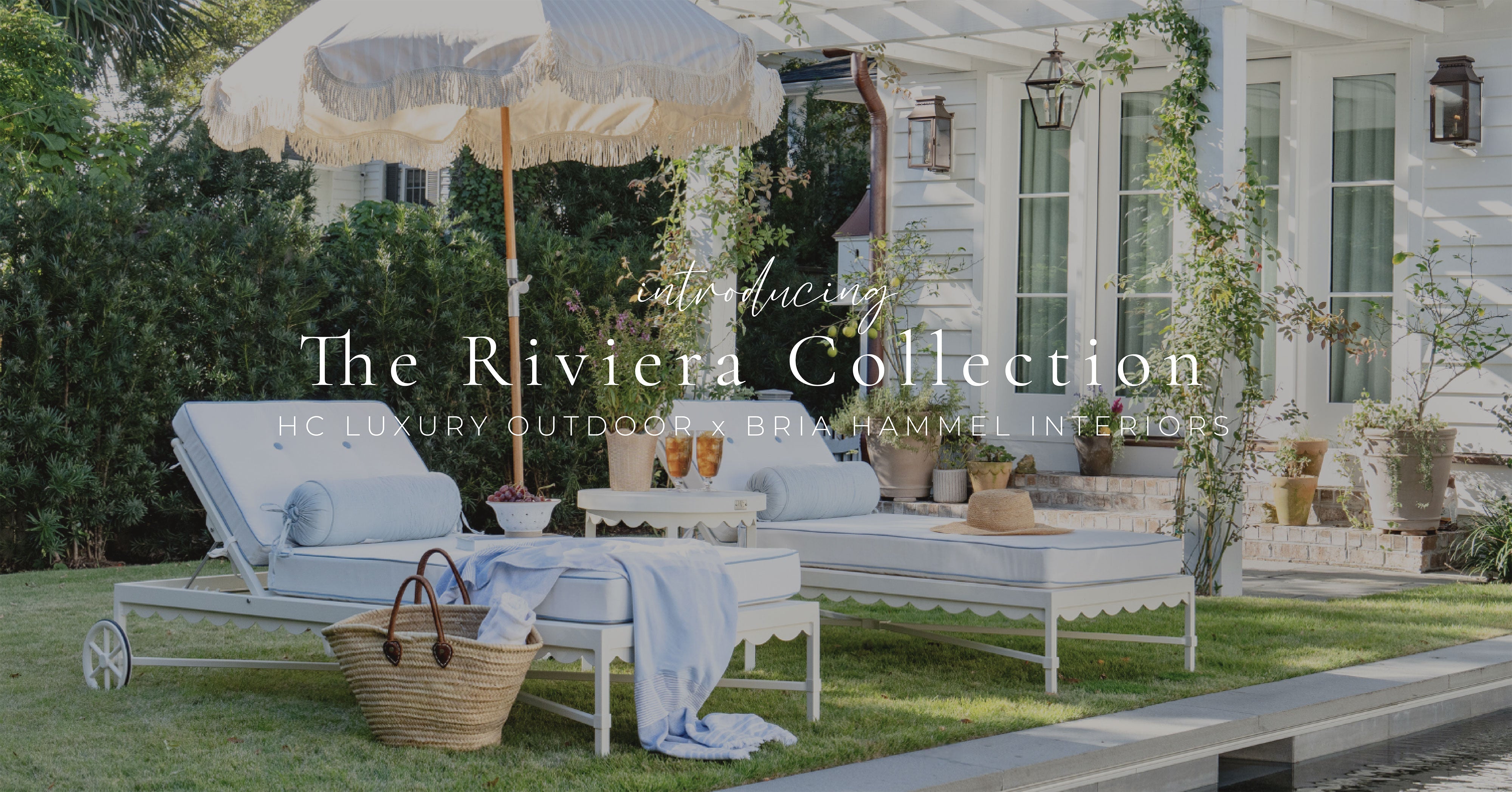Cast aluminum vs. aluminum patio furniture, what is the difference? When you pick one up to move it, you will instantly know which is which. But that is not all there is in difference and this informational article will breakdown all of the differences.
If you’ve ever dreaded moving a piece of aluminum furniture only to discover that it’s lighter than a feather, you may have encountered a piece made from extruded aluminum, also known as hollow aluminum. Hollow aluminum is lightweight and durable, making it a popular choice for patio furniture.
Cast aluminum, however, is solid aluminum. As a result, cast aluminum is heavier than hollow aluminum. That said, both types of aluminum have their advantages and disadvantages.
With the information in this article, you’ll be better able to better understand the difference between cast aluminum furniture and hollow aluminum furniture. This will allow you to elevate your patio and home decor and find the perfect outdoor aluminum furniture options for you.
Production of Each Type of Outdoor Furniture
You’ve probably heard of cast iron furniture, but you may not have heard of cast aluminum patio furniture. In short, casting refers to the process in which liquid metal (molten aluminum) is injected into a furniture mold. As a result, the furniture is solid. Any metal, including aluminum, can be cast.
Hollow aluminum follows a different production process. Let’s take a closer look at the methods involved in producing these two aluminum types.
How Cast Aluminum Furniture is Made
As stated above, cast aluminum is simply solid aluminum. To cast aluminum, manufacturers may follow one of several processes:
- Permanent mold casting – Permanent mold casting involves injecting molten aluminum into a reusable metal mold. Because the mold is reusable, you can use the mold to create many uniform furniture pieces.
- Sand casting – Sand casting is similar to permanent mold casting in that liquid aluminum is poured into a mold. However, unlike permanent mold casting, the sand-casted mold is discarded after use.
- Die casting – Die casting is almost the same as permanent mold casting except for one crucial difference: how the mold is filled. Whereas permanent mold casting uses gravity to fill the mold, die casting relies on pressure.
Whichever the casting method, casting aluminum produces aluminum furniture that is heavy and durable.
How Hollow Aluminum Furniture is Made
Hollow aluminum is made through a process known as extrusion. Put simply, aluminum extrusion involves passing aluminum through a machine that cuts and shapes the metal according to the furniture’s design. Unlike cast aluminum, liquid aluminum isn’t poured into the shaped piece.
In recent years, aluminum extrusion has risen in popularity in the furniture industry. That’s because hollow aluminum has the following advantages:
- Strength – While you may think cast aluminum is stronger than hollow aluminum based on its weight, hollow aluminum is also quite strong. Heat treatments can further enhance its strength.
- Sustainability – As far as metals go, aluminum is sustainable and cost-effective. Given that hollow aluminum creates less mass than cast aluminum, hollow aluminum may be even more cost-effective and eco-friendly.
- Strength-to-weight ratio – Some metals are strong but not light. Other metals are light but not strong. Hollow aluminum packs the best of both worlds, making it ideal for outdoor patio furniture like chairs and tables.
Weight of Aluminum Furniture
As stated above, cast aluminum tends to be much heavier than hollow aluminum. That said, cast aluminum is still lighter than most other casted metals—especially iron.
If you live in an area prone to high winds, cast aluminum outdoor furniture may be for you. The sturdier aluminum frame may keep the furniture piece upright even in the windiest conditions.
However, hollow aluminum can still hold its own in moderate winds. Furthermore, hollow aluminum’s lighter weight may benefit:
- Households with seniors or children – Seniors and children may not have the strength to move cast aluminum. They can most likely move hollow aluminum, however.
- Patios that frequently change the design – If you often change the look of your patio, hollow aluminum may be the right choice for you. That’s because hollow aluminum’s lighter weight means you can easily move your furniture whenever inspiration strikes. For instance, if you want to move your aluminum chaise lounge closer to the pool, hollow aluminum can make the move much easier.
- Big moves – Moving can already feel like a chore. Cast aluminum’s heavier weight may make this process even more of a burden. Fortunately, hollow aluminum furniture can make loading the moving van that much less demanding.
Design Differences Between Cast Aluminum and Hollow Aluminum
Like cast iron, cast aluminum often features intricate, ornate designs. That’s because cast aluminum molds allow for more detail during the manufacturing process. In many ways, cast aluminum furniture is more than functional—it may also be aesthetically pleasing.
That said, hollow aluminum furniture can be just as beautiful as cast aluminum furniture—especially if you want to create a modern patio.
The sleek lines and angular cross-sections of hollow aluminum furniture can transform your patio space while remaining warm and inviting. Some hollow aluminum dining tables even use teak to further merge functionality with everyday elegance.
The Corrosion and Rust-Resistance of Aluminum Furniture
Unlike many other metals, aluminum is quite rust-resistant. This makes both cast aluminum and hollow aluminum ideal for patios exposed to wind, salt, and surf. Aluminum is likewise very resistant to corrosion.
The common misconception is that aluminum never rusts. However, the truth is that aluminum can rust. Aluminum’s rusting process is just different from other metals.
If your aluminum patio furniture does rust, you can use one or all of the following to remove the rust and to keep your outdoor furniture clean and looking its best:
- Cola
- Ketchup
- Other aluminum
- Sandpaper
You’re in even better shape if your aluminum outdoor furniture contains powder coating. Powder-coated aluminum helps prevent rust and corrosion. If you do choose the powder-coated option, our guide on how to clean powder-coated aluminum patio furniture will be an excellent resource for you.
Placement of Your Patio Furniture
If you’re wondering how to arrange patio furniture, look no further. Cast aluminum furniture typically features an ornate design. This design, coupled with the fact that cast aluminum is heavier, means that most people place cast aluminum furniture in semi-outdoor spaces.
These spaces usually include:
- Courtyards
- Gardens
- Corridors
- Pergolas
- Covered patios
Cast aluminum is ideal for these spaces, as they may host more formal events.
Conversely, hollow aluminum may be better for totally-outdoor spaces. These spaces include:
- Traditional patios
- Pool areas
- Grill areas
Totally-outdoor spaces tend to host more informal events. These events include pool parties, cookouts, backyard gatherings, and movie nights. As a result, people often move furniture around in these areas.
Maintenance of Aluminum Outdoor Furniture
Both cast aluminum and hollow aluminum are relatively easy to maintain. Aluminum’s low-key maintenance largely stems from the metal’s resistance to rust and corrosion. However, like most outdoor patio furniture, aluminum patio furniture will likely require the occasional cleaning.
Take the following steps to maintain your aluminum patio furniture:
- Remove any cushions from your furniture and spray your outdoor pieces with a hose.
- After the preliminary wash, remove any leaves, caked-on mud, and other stuck-on debris from your aluminum furniture with a wire brush.
- Add mild detergent to a bucket of water and start scrubbing your aluminum furniture with a sponge. After scrubbing your furniture, spray it once more with your hose.
- Completely dry your aluminum furniture with a non-abrasive towel.
Although you’ll generally use the same cleaning procedure for cast aluminum and hollow aluminum furniture, hollow aluminum furniture may be easier to maintain.
That’s because cast aluminum’s ornate design may make cleaning the furniture’s nooks and crannies more difficult. Hollow aluminum’s sleek, striking design can simplify the patio furniture cleaning process.
The Durability of Aluminum Patio Furniture
Cast aluminum and hollow aluminum make for very durable furniture. However, cast aluminum may win out when it comes to ultimate longevity. That’s because cast aluminum is heavier and thus more impervious to dents and wind damage.
That said, hollow aluminum can be just as durable. The key is to select high-quality aluminum furniture pieces built to resist the elements.
Storage of Cast Aluminum vs. Hollow Aluminum Furniture
Hollow aluminum furniture is generally easier to store than cast aluminum furniture. That’s because hollow aluminum furniture features tubular designs and lighter weights. As a result, this aluminum type lends itself to stacking. So when you need to change your outdoor home decor, just store and stack it away until you need it.
Cast aluminum may be more difficult to store. That’s because cast aluminum typically features more intricate designs and heavier weights.
Storage convenience becomes especially important during inclement weather. While both aluminum types can withstand stormy weather, weather events such as hurricanes and tornadoes can often pick up furniture regardless of construction.
Cost of Cast Aluminum vs. Hollow Aluminum Furniture
Although many factors determine the cost of patio furniture, hollow aluminum furniture tends to be less expensive than cast aluminum furniture. That’s because the former typically uses fewer materials in the manufacturing process.
However, hollow aluminum’s elegance can often exceed that of cast aluminum. For instance, a spiffy aluminum outdoor ottoman can radiate style and sophistication through its clean, precise lines.
The Weather-Resistance of Both Furniture Options
As stated above, cast aluminum and hollow aluminum are exceptional choices for areas that receive a lot of rain, wind, and sun. Aluminum furniture is remarkably rust and corrosive-resistant.
That said, you may need to move patio furniture inside during especially nasty storms. It may also be wise to move your furniture into storage during the winter. Hollow aluminum’s lighter weight makes transporting patio furniture into storage much more convenient.
HC Luxury Outdoor Aluminum Furniture: Timeless Aesthetic, Everlasting Appeal
When deciding between cast aluminum vs. aluminum patio furniture for your outdoor space, you’ll likely need to consider several factors. These factors include your furniture’s intended placement and how often you move your furniture.
Luckily, our line of stylish aluminum furniture makes this choice easier than having a Mai Tai on a chaise lounge.
Whether you’re looking for your next aluminum chair, lounge, or table, HC Luxury Outdoor can help transform your patio—one piece at a time.
Sources:
Elegant Outdoor Spaces. How to Clean Cast Aluminum Patio Furniture. https://elegantoutdoorspace.com/how-to-clean-cast-aluminum-patio-furniture/#Difference_between_Aluminum_furniture_and_Cast_Aluminum_furniture
Le Claire Manufacturing Co. Which Aluminum Casting Method is Right for You? https://www.leclairemfg.com/about-us/blog/which-aluminum-casting-method-is-right-for-you/
Silver City Aluminum. Growth of Aluminum Extrusion Design in the Furniture Industry. http://scaluminum.com/2019/04/growth-of-aluminum-extrusion-design-in-the-furniture-industry/
Tomburn. Does powder coated aluminum rust? https://www.tomburn.com/case-study/5e79e37514eb9/Does-powder-coated-aluminium-rust



